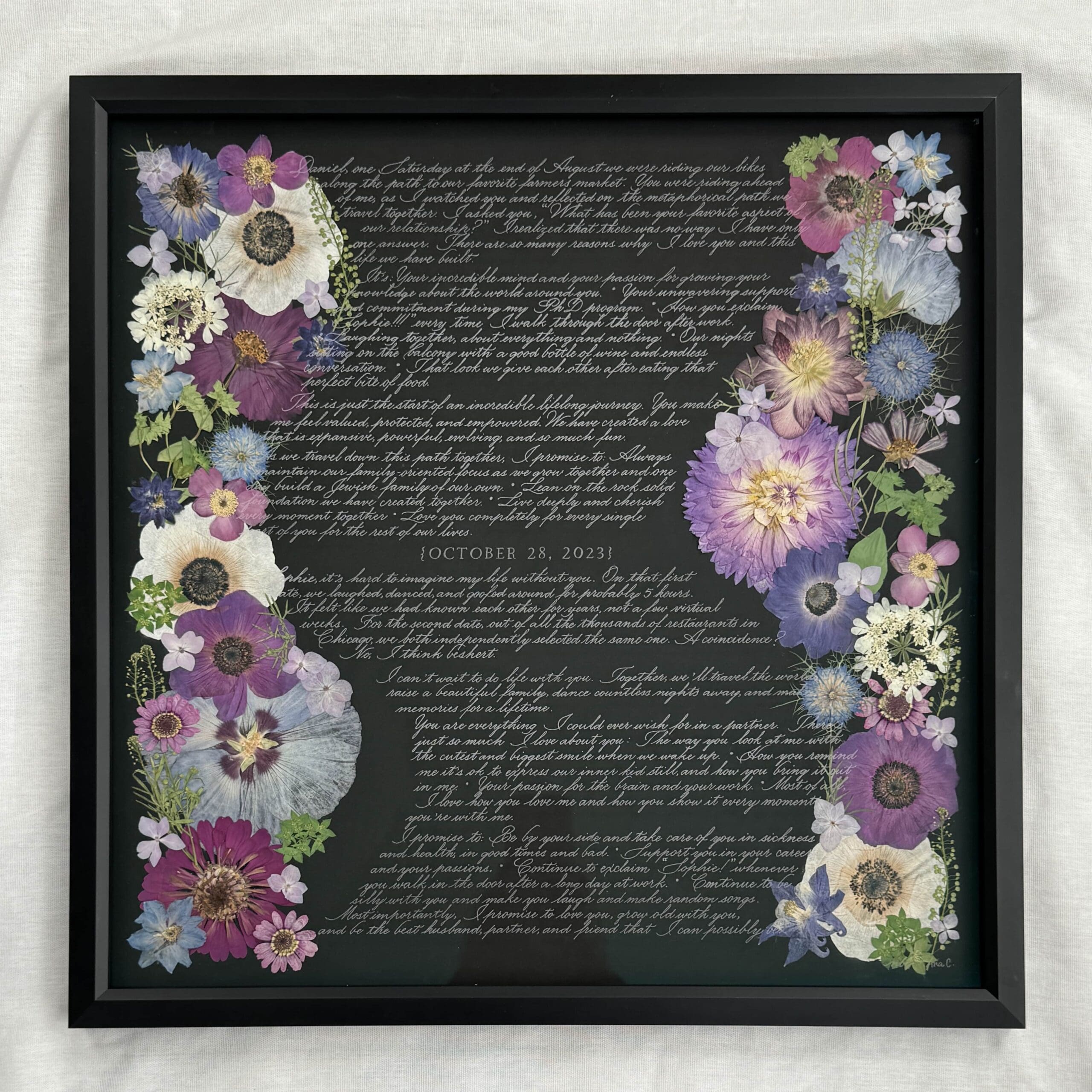
400 engraved words. Dozens of pressed flowers. Two months of planning. One of a kind and all the feels.
With the variety of fun and beautiful projects I get to do in my work, it’s hard to pick a favorite one. When it comes to custom commissions, though, this engraved frame of preserved flowers is truly like nothing else I had ever done—or even seen—before.
It began when my client, Sari, reached out to me asking for something unique and personal for her sister-in-law’s post-wedding gift. Right away in our conversation, it was apparent how special the bride and groom were to her. She spoke with such love and warmth about the couple and their wedding vows, and she really wanted the newlyweds to have a gift that celebrated them.
After some time throwing ideas around, we set out to create a piece that: 1) had the vows engraved, and 2) included the same (or similar) flower colors from the wedding, to give it a little pop. I proposed my vision of framed pressed flowers with the vows engraved in the foreground, and we were soon on our way.
This is where the fun—and challenges—began.
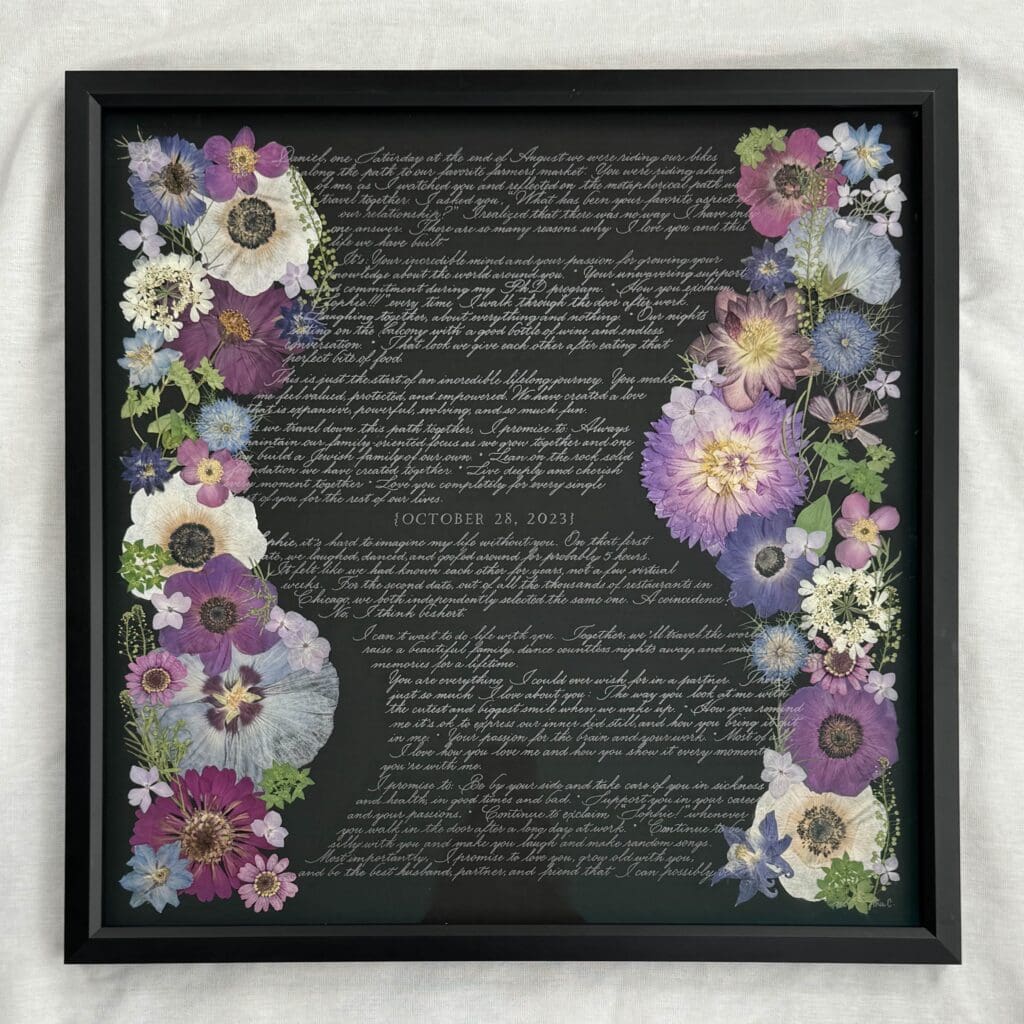
Let’s start with the vows.
When Sari sent me copies of Sophie’s and Daniel’s vows to each other, I was so touched; their words were so sweet, personal, and vivid. I felt like I had a seat at the wedding and knew the couple. Their words were also plentiful: 1,415 of them. Not all of them were going to fit on a 20×20 glass, nor in the given budget.
Paring others’ words takes much care and consideration. Editing 1,415 words of heartfelt wedding vows down to 400 isn’t just about cutting—it’s about keeping what matters most. Every word is personal. The challenge is choosing the lines that carry the deepest meaning, complement the vision of the piece, and let the emotions breathe.
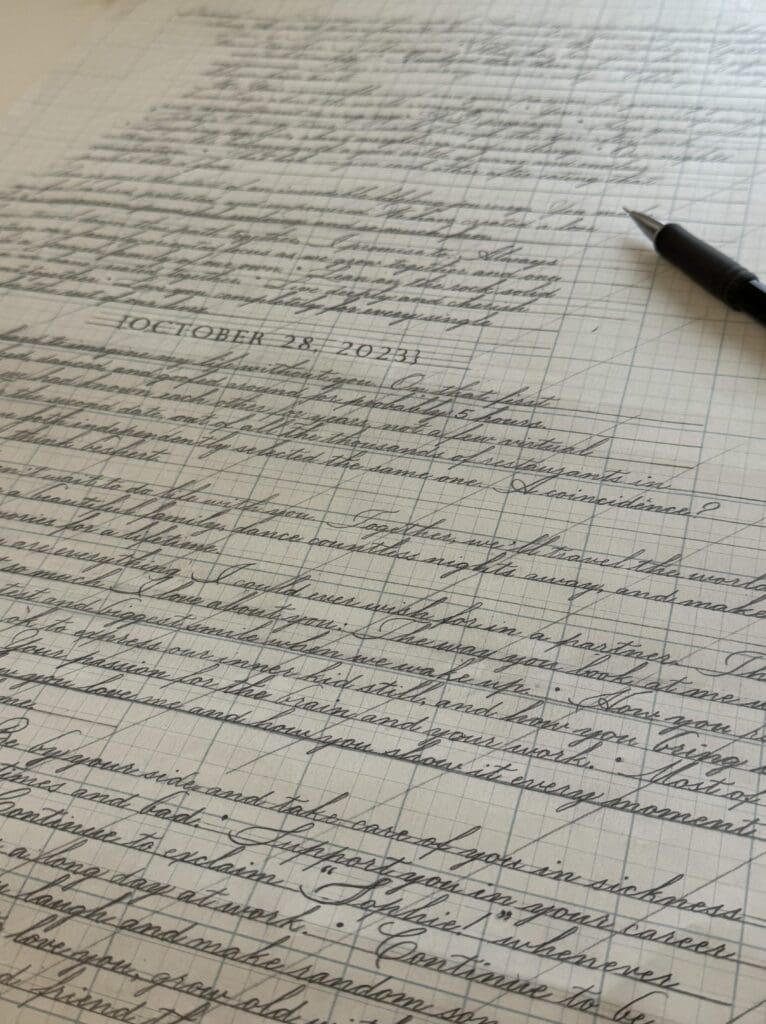
Finding a pressed flower artist.
I’m going to make a couple of slightly embarrassing confessions here:
- First off, I first entertained arranging the pressed flowers myself. (Say whaaaaat?!) Mind you, I’d never done this before. After some dizzying online searches on dried flowers and how-to’s, I wisely abandoned this idea and decided to leave this art to an artist who specializes in it.
- Secondly, I didn’t look at local artists first. “For real?” you say…sigh, yes. I went straight to Etsy (as it seemed less intimidating to the introvert in me), I looked through dozens of framed dried floral art pieces, and reached out to the creators there. Now, let me state that the quality of the work with the handful of creators I reached out to seemed great. But as you likely know, Etsy is flooded. It took a lot of time sifting through all the products and makers. And when I finally got in touch with some, they were in different parts of the country. The logistics of coordinating a project like this, for the first time, with vendors far away, were going to be costly in time and dollars. So I finally got wise and asked for help from local wedding vendors, who quickly sent me wonderful recommendations.
My search ended with Ana Constantinescu, the artist and owner of Bloom and Make (see her work below and be as wowed as I was!). From our first conversation, it was clear that Ana knows her stuff and would make a great collaborator. For example, one of the first questions she asked me would be one of the most important for my work on the project: Would engraving on museum glass, which is treated to reduce glare and filter UV light, be an issue?

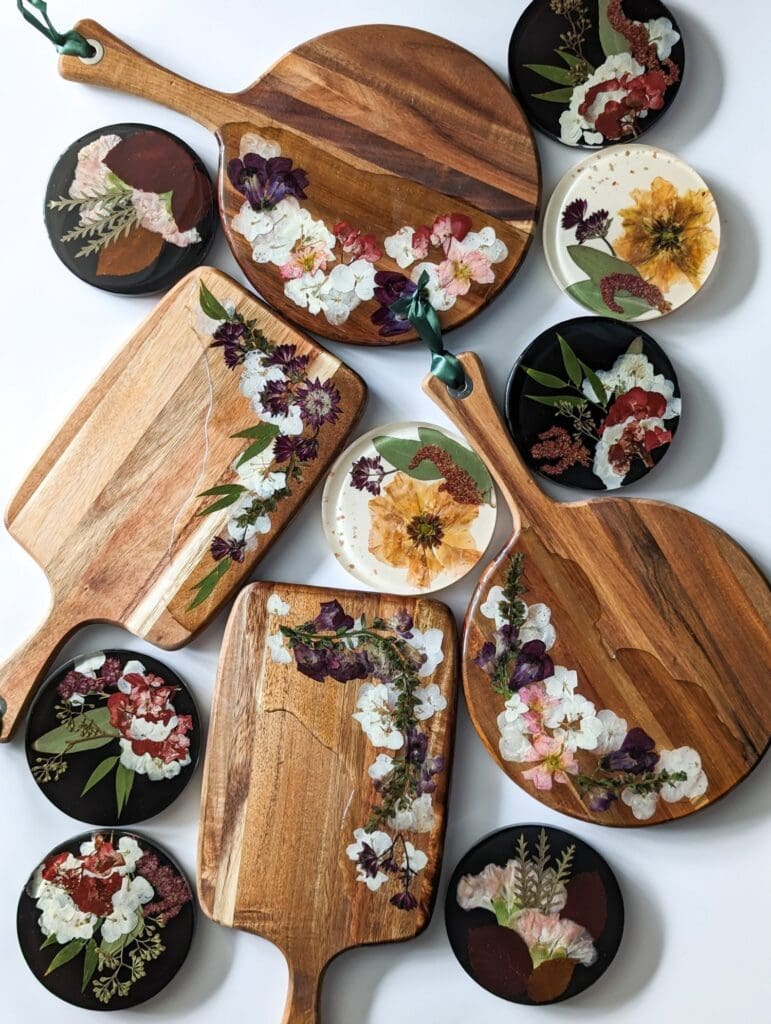

We needed museum glass to prevent fading in the flowers, no question about it. And since I hadn’t engraved on museum glass before, I ordered a sheet to practice on. Engraving on museum glass would thankfully not be a problem. It was still different than engraving on regular untreated glass, though, and I had to engrave on a specific side. Ana’s question provided necessary information in my trial-and-error practice before engraving on the final piece.
Designing the layout.
I had secured a floral artist; I got the custom framing service (Ana does framing for her pieces as well, but we agreed that if I found someone else for this, the project could be done within the desired timeframe); and I completed editing the vows. It was time to create the design.
I presented the text drafted in a few different ways, along with the floral mockups provided by Ana. Sari chose the design that was also my personal favorite. A few reasons why I was so excited by this layout:
- The path design was inspired by a special bike ride mentioned in the bride’s vows. This was not some template design, it was literally an “aha” moment visualized by something very specific to this couple.
- A path is a classic representation of a journey, and the couple’s vows were eloquent and loving dedications to their life’s journey together.
- A single path bridged two separate vows together in a unified shape, split only by a line for the wedding date.
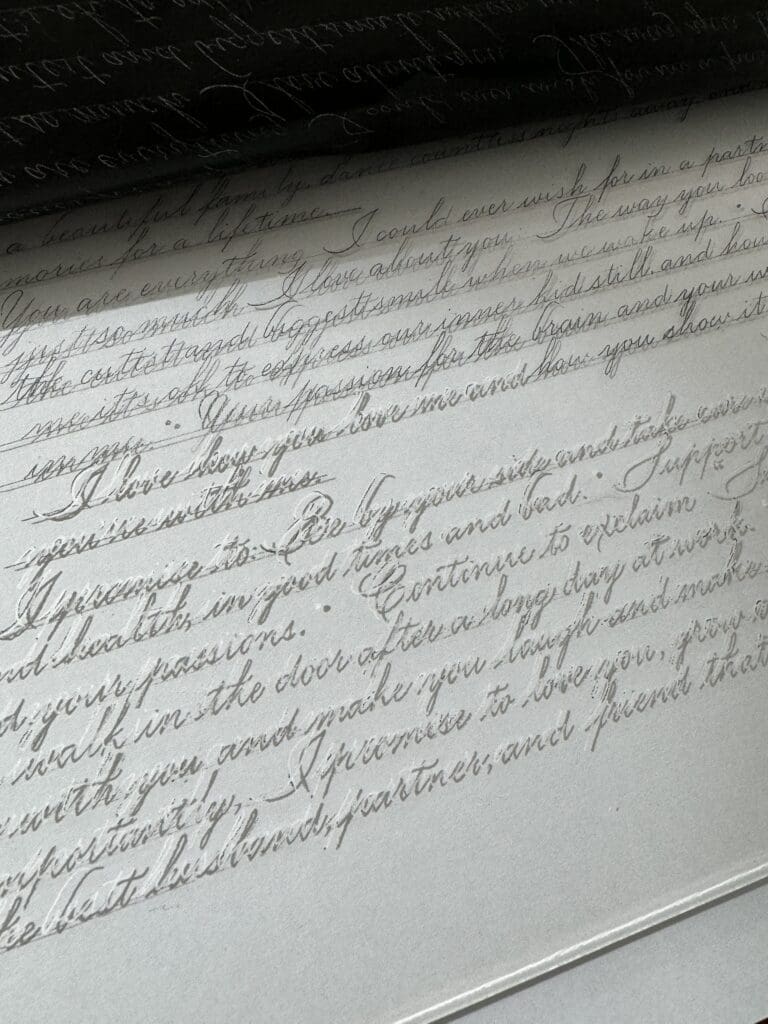

Bringing it all together, separately.
We had to work separately and simultaneously to meet the shortened timeframe. Talk about trusting the process—and each other! Yes, we did mockups beforehand, but mockups are merely digital renderings of the actual piece of art. I had one shot to pencil in, then engrave, 400 words on a 20×20 sheet of museum glass. Ana handled the flowers used in the final piece sparingly, due to the delicate nature of pressed flowers.
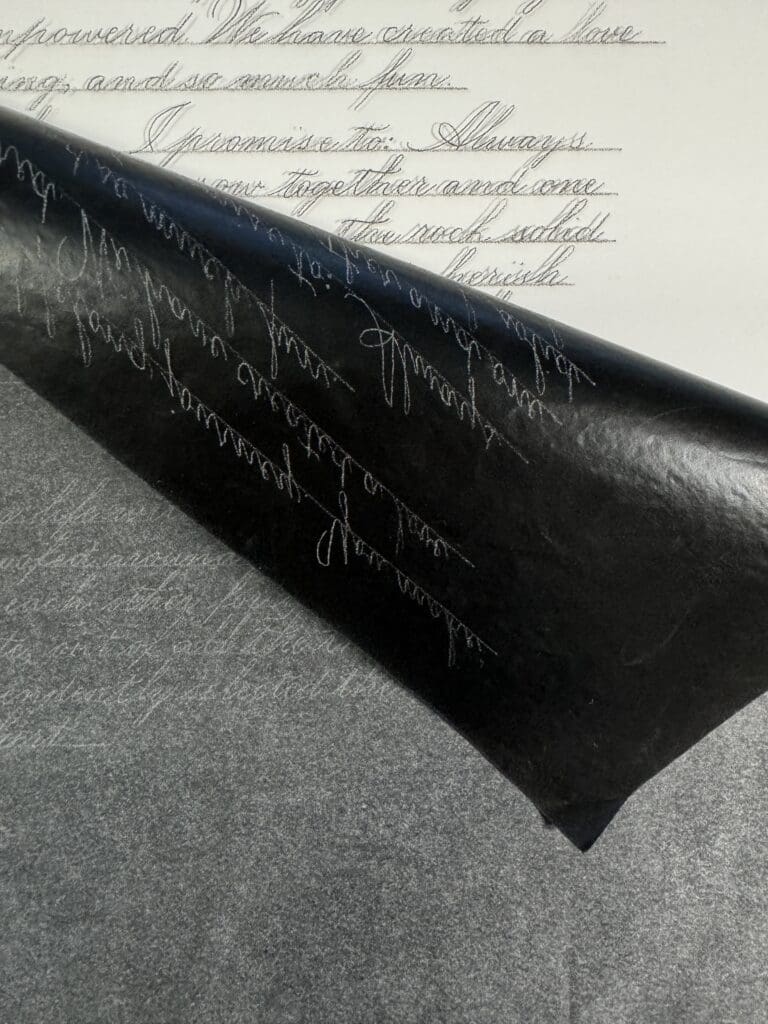

Here were my steps for engraving the vows:
- Draw guidelines on large grid paper. Make note of where start and end points are on each line to create the curved path shape.
- Proofread the mockup text for the tenth time.
- Pencil in the text on the grid paper (400 words). Proofread again and again.
- Place graphite/carbon transfer paper on top of the museum glass. Then place the grid paper with penciled text on top transfer paper. Trace over the penciled text (400 words, again…that makes 800).
- Remove paper layers from glass. Proofread, proofread, proofread.
- Engrave (400 words, again…that makes 1,200).
Meanwhile, Ana picked the flowers that would be used in the frame—all from her own garden, many of which she grew from seed. She also did a gentle color enhancement process to preserve the flowers’ colors and vibrancy over time. Lastly, she arranged the flowers to align with the measurements of the path design and skillfully glued the delicate dried blooms in place to the mat.
Once the engraved glass and floral mat were complete, it was time to bring them in for framing. Shout out to the wonderful team at Frame Factory in Lincolnwood. Their guidance in frame choice and excellent care in putting the final touches on rounded out this collaborative artwork.
A piece like this isn’t easily forgotten. In the days after this work was first shared, I heard from clients and followers alike who were moved by the story behind the design. While each couple’s story is singular, the desire to commemorate love in a heartfelt, meaningful way is universal. If you’re dreaming of a piece that speaks to your own journey, let’s begin shaping it together.

Tips on ordering pressed flower art, from Ana Constantinescu of Bloom and Make:
How soon should clients book for floral preservation?
Because I have limited capacity, the earlier the better, especially if the wedding takes place during the busy months (May through October). In real terms, if the wedding is in July, I recommend booking preservation services in January-February, so roughly 6 months ahead. And I realize it’s a new type of service— many people still don’t know that flowers can be preserved as wall art or functional decor. So I try to accommodate last-minute requests, especially for memorial inquiries.
What to expect for turnaround time?
Typically, it takes up to 12 months. However, I’m always happy to work with my clients on reasonable requests for quicker turnaround times. This guide expands on why the lead time is so long, especially for independent, solo artists like myself.
Other things clients should know?
My #1 recommendation for prospective clients is to choose a flower preservation artist with the same criteria in mind as the floral designer and photographer. It’s about vision, skills and responsiveness.
I’d also like to emphasize that flower preservation is fundamentally an imperfect art form that uses organic matter as an art medium. That means flowers – some more than others – will change color, shape and texture during the pressing or drying stage. Their appearance will also be altered in contact with resin. Imperfections will be visible, though it is tough to tell when you scroll through someone’s carefully curated Instagram feed. The reality is that it is very, very easy to alter or edit photos or videos – air bubbles in resin can be removed, color filters can be applied and camera angles can be manipulated. All this is to say that perfection rarely exists in flower preservation. And that is ok if you are prepared for it!